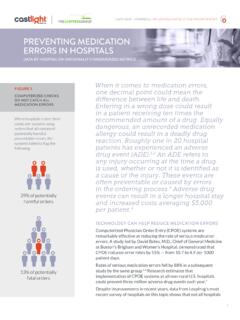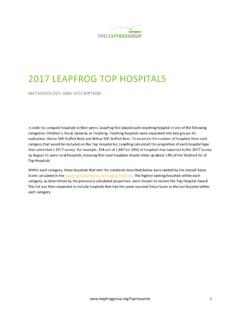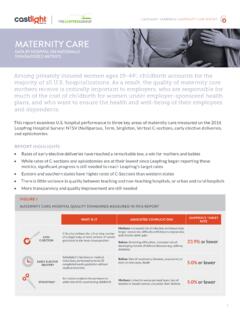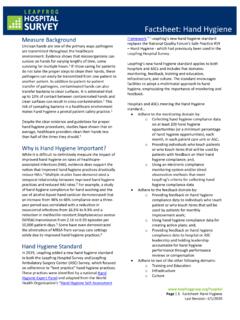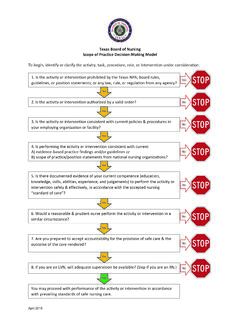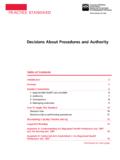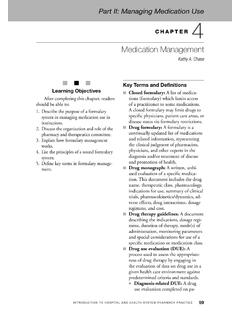Transcription of Bar Code Medication Administration - Leapfrog
1 1 Bar Code Medication AdministrationData by hospital on nationallyreported metricsReport Highlights Most reporting hospitals have a bar code Medication Administration (BCMA) system connected to an electronic Medication Administration record (eMAR), but only one-third fully meet Leapfrog s BCMA standard for safe and effective implementation of the system Hospitals not meeting the Leapfrog standard are most often failing by not scanning both the patient and Medication at least 95% of the time or not having adequate decision -support elements in place Nearly four out of five hospitals have all five of Leapfrog s recommended processes and structures in place to monitor and reduce workarounds that diminish the capacity of bar coding to improve patient safety Urban hospitals were more likely to fully meet
2 The standard than rural hospitals, and teaching hospitals showed greater improvement from 2016 to 2017 than non-teaching institutionsMedication errors result in an estimated million adverse drug events (ADEs) in the The typical hospitalized patient is exposed to at least one Medication error daily,2 with those mistakes contributing to an estimated 7,000 deaths each But with proper safeguards and use of technology such as bar code Medication Administration lives could be saved. Bar code Medication Administration (BCMA) systems scan a patient s wristband and Medication to be given in order to prevent Medication errors.
3 Preventable Medication errors impact more than 7 million patients and cost almost $21 billion annually across all care In one study, the use of BCMA was associated with reducing Medication Administration errors by up to 93%.5 Leapfrog has developed the only national standard for using BCMA at the bedside and the annual Leapfrog Hospital Survey is the only source of publicly reported data on hospitals use of BCMA systems to prevent bedside Medication errors enabling patients to make well-informed choices about where to seek care. Minimizing Adverse Drug EventsAn ADE occurs when a patient is harmed due to Medication .
4 In these cases, a decimal point error, overlooking patient allergies or a potentially harmful drug interaction, and/or confusing similarly named drugs could cause death or a serious systems linked with eMARs are designed to prevent Medication errors at the point of administering Medication to patients at the bedside. A nurse or other clinician administering Medication scans a bar code on a patient s wristband to confirm he or she is the right patient, and then scans a bar code on the prescribed Medication to verify the right drug, dose, and time of delivery. The system also connects with the electronic medical record to check vital signs and allergies and call for backup support if needed.
5 2 Assembling a national panel of experts,6 The Leapfrog Group examined best practices for BCMA, including its proper use and how to avoid workarounds that could nullify the benefits in developing a standard for hospital adoption of BCMA. Publicly reported for the first time on the 2016 Leapfrog Hospital Survey, this report, based on the 2017 Survey, provides key insights into the progress made to date and the room for improvement that still Progress, but Significant Improvement NeededNearly all reporting hospitals ( ) have a BCMA system implemented in at least one inpatient unit with the vast majority of these hospitals ( ) using the system in all applicable However, only of reporting hospitals fully met all four requirements of the BCMA standard (Figure 1).
6 This represents an improvement from the of hospitals that fully met the standard in 2016. Another of reporting hospitals have made substantial progress toward the Leapfrog standard, meeting three of the four criteria. An additional of hospitals met two of the four requirements (Figure 2).A Closer Look at Where Hospitals are Falling ShortOf hospitals reporting that they lack at least one of the four requirements for Leapfrog s BCMA standard, the most disappointing lapse and dangerous from a patient safety perspective is that are failing to scan both the patient and the Medication for at least 95% of bedside Medication administrations.
7 This means that more than two in five hospitals that have implemented BCMA technology simply aren t using it consistently enough to safeguard all their 1: About BCMAWhat it isAn electronic scanning system that intercepts Medication errors at the point of Administration . By scanning bar codes on a patient s wristband and on prescribed medications, nurses or other clinicians can confirm that they have the right patient, right Medication , and right dose, given at the right Ensures that patients receive the right Medication in the right dosages, when needed Provides a valuable double check on the clinical reasoning of pharmacists and nurses Adds efficiency by eliminating manual recording in a patient s chart and updating the hospital s electronic health record (EHR)
8 SystemLeapfrog s Standard Implement a BCMA system linked to an electronic Medication Administration record in 100% of the hospital s medical and/or surgical units (adult and pediatric), labor and delivery units, and intensive care units (adult, pediatric, and neonatal) Scan both patient and Medication bar codes in 95% of bedside Medication administrations in BCMA-equipped units Use a BCMA system that includes all seven decision -support elements identified as best practices by the Leapfrog BCMA Expert Panel Implement all five best-practice processes and structures to prevent workarounds of the BCMA systemFIGURE 2.
9 How Hospitals Measure up on meets standard(all 4 criteria)Substantial progress(meets 3 of 4 criteria)Some progress(meets 2 of 4 criteria)Willing to report (meets 0 or 1 criteria) 3 Another frequent omission ( ) was hospitals not having all seven decision -support elements in place to help guard against Medication errors. Only about three in five ( ) of reporting hospitals with a BCMA system in place in at least one inpatient unit had all seven types of decision support. The decision -support elements most likely to be missing were a built-in vital sign check ( of those reporting and missing one or more decision supports) and a patient-specific allergy check ( ) (Figure 3).
10 Working to Avoid Dangerous WorkaroundsHuman error is unavoidable. The effectiveness of any technology is only as good as the effectiveness of its implementation in the delivery of care. Even when BCMA systems are well designed, problems can arise that force users of the system to act outside of the prescribed norms. The Leapfrog BCMA standard incorporates five best-practice processes and structures to prevent the workarounds that undermine the efficacy of BCMA as a patient safety tool. These include: A formal committee to oversee BCMA use Backup systems for hardware failures A help desk to respond to BCMA issues in real-time Conducting real-time observations of staff using the BCMA system Engaging with nursing leadership on BCMA usageMost ( ) of the hospitals that have implemented BCMA systems have incorporated all five recommendations to guard against workarounds.

